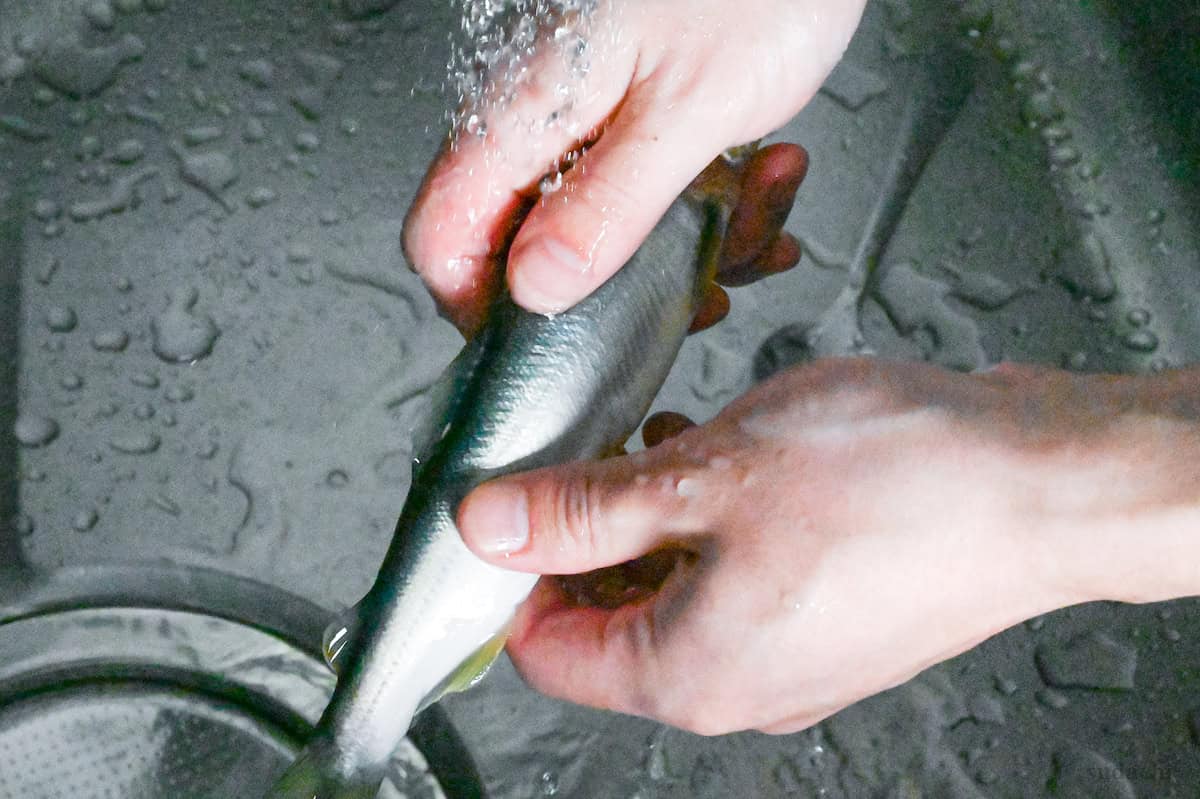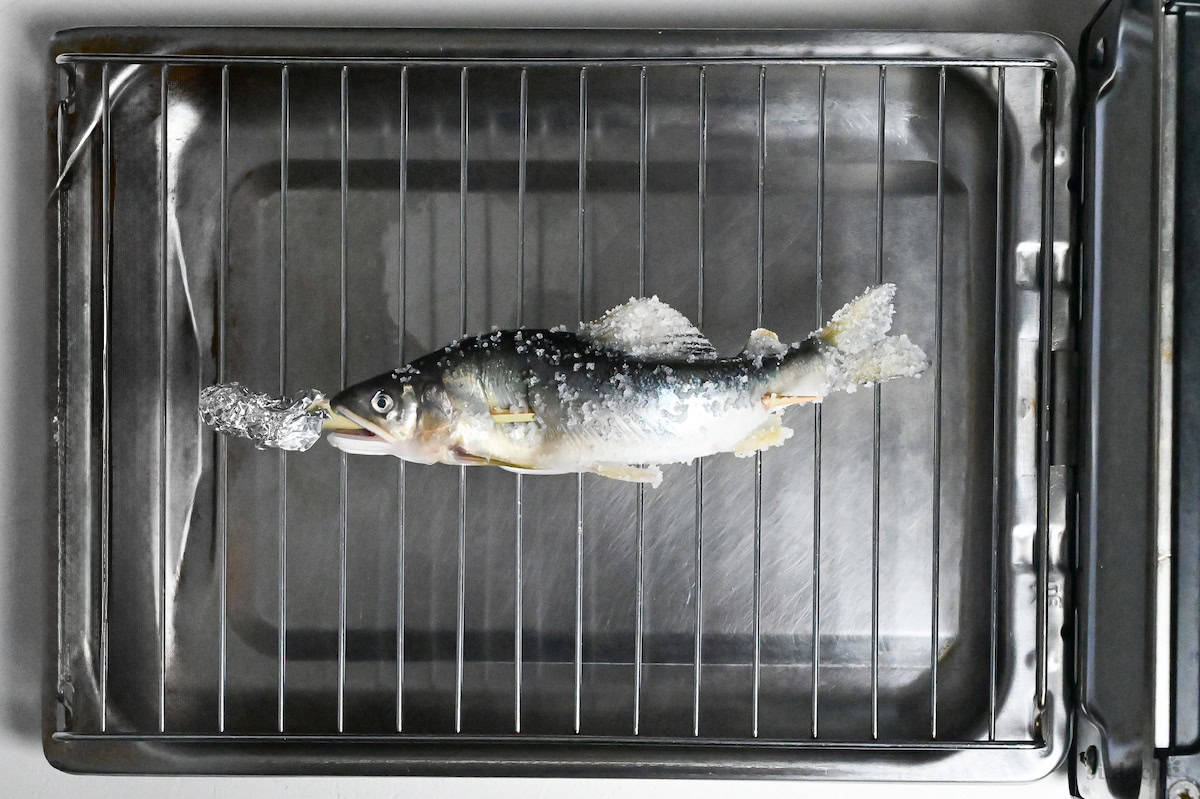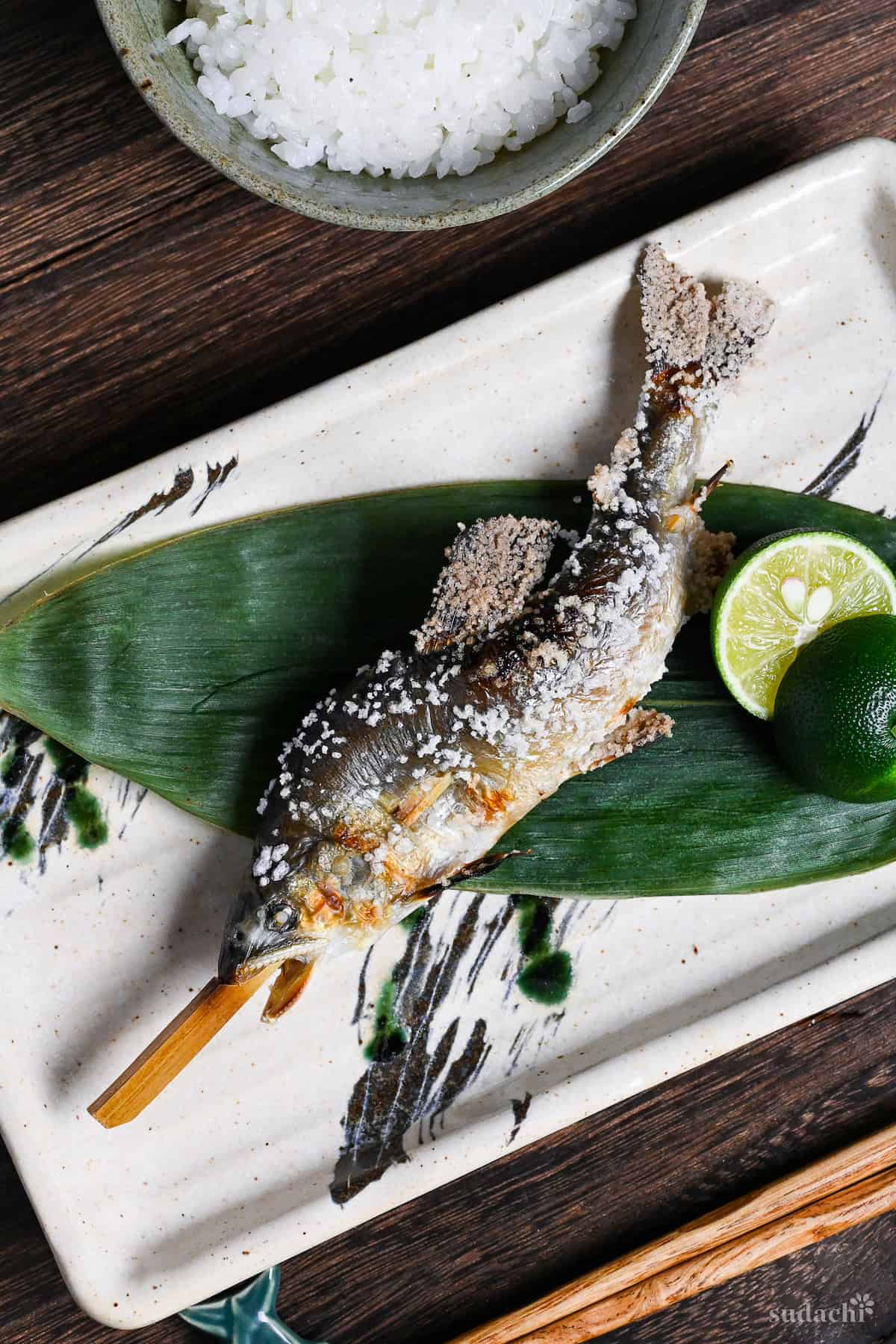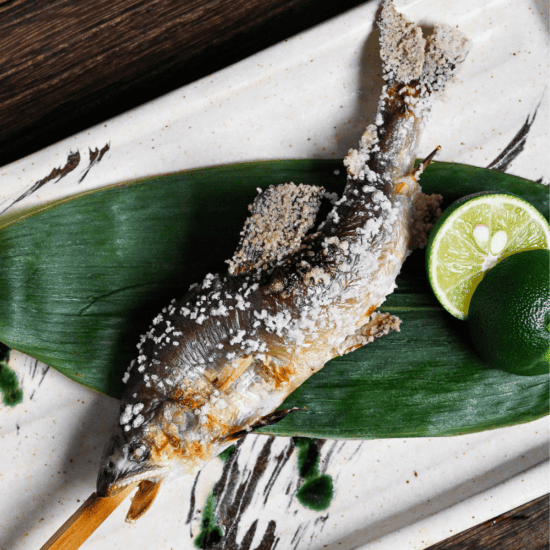What is Ayu no Shioyaki?
Ayu (鮎/sweetfish) is a symbolic summer river fish in Japan that’s only available for only a brief window each year. If you play animal crossing (like my wife) then you might already be familiar with sweet fish. In many regions, fishing restrictions from November to May mean you can only enjoy this delicacy from June to October.
The best way to enjoy it is simply grilled with salt! When I was a kid, I used to watch TV shows and anime that featured this traditional fish, and I would dream of tasting it myself. It just looked so one of a kind.
Shioyaki (salt grilling) is a traditional Japanese method of preparing fish and is most often associated with salmon and mackerel, which are commonly served with breakfast. Salt-grilled sweet fish, on the other hand, are usually seen at restaurants or festivals and served on skewers in a wave shape to look like they’re still swimming.
While salt-grilling is straightforward, ayu requires special prep. In this guide, I’ll walk you through everything you need to know to perfectly prepare grilled ayu at home!

Visual Walkthrough & Tips
Here are my step-by-step instructions for how to make Ayu no Shioyaki at home. For ingredient quantities and simplified instructions, scroll down for the Printable Recipe Card below.
This section aims to provide a comprehensive overview of the cooking steps and techniques with visuals. It also includes more in-depth tips and tricks and explains why I do what I do.
First, rinse the ayu under cold running water. Then, use the back of a spoon to gently remove the natural protective coating from the skin.

Just be careful not to damage the delicate flesh beneath, and you’ll get a nice, clean flavor without any muddiness.

After cleaning, hold the fish with its belly facing outward and gently press from just below the gills toward the tail using your thumb and index finger. This removes any digestive contents and prepares the fish for cooking.
Pat the fish thoroughly dry with paper towels.
Poke a bamboo or metal skewer through the fish’s mouth and guide it through the body until it comes out at the yellow spot near the tail (that’s called “oiboshi” in Japanese).


Make a slight curve in the skewer to copy the fish’s natural swimming motion. This isn’t just for looks; it helps make sure the fish cooks evenly.

In Japanese cuisine, the fish’s head is always on the left when it’s served. This is based on traditional presentation aesthetics, so keep that in mind when you’re preparing your skewers.
For the best presentation, stick the skewer through the back of the fish so you can’t see it when it’s on the plate.
Here’s an important Japanese technique called “Kesho Jio (化粧塩)” that makes all the difference. Just stretch the tail fin a bit and apply a good amount of salt. The salt acts as a protective barrier that prevents the delicate fin from burning during grilling.

For salting the body, first sprinkle sea salt on a surface, then gently press the fish onto the salt to coat the underside evenly. Hold your hand about 30 cm (12 inches) above the fish as you sprinkle salt over the top side. This height allows for even distribution of salt across the entire surface.

Properly distributed salt not only seasons the fish but also helps draw out excess moisture from the skin, contributing to that perfect crisp exterior while keeping the flesh moist.
Make sure your grill is nice and hot before you start cooking. If you’re using a Japanese fish grill, set it to medium-high heat. For Western-style grills, aim for about 375°F (190°C).
Tip: Wrap the end of the skewer with foil to prevent burning.

Start with medium heat for the first 4-5 minutes, just until the skin starts to look nice and colored. Then, reduce to medium-low heat to allow the interior to cook gently without burning the exterior.
For single-sided grills, cook it until the edges are golden (about 5 minutes), then carefully flip and repeat.
But the time really depends on the type of grill you use, so it’s better to judge by appearance rather than cooking time.
Look for an evenly golden-brown exterior with slightly crispy skin. The eyes should turn white, and the flesh should be just opaque all the way through.

Serve it right away with a slice of citrus fruit (I used sudachi). The bright acidity really brings out the rich, slightly bitter flavors of the grilled ayu.
Since Ayu no Shioyaki is usually served as street food, it can eaten straight off the skewer, bones, head, guts, and all. This is totally optional and I personally don’t eat the head or guts.
Jump to Full Recipe MeasurementsEssential Tips & Tricks
- Watch your salt application – Sprinkle salt from about 12 inches above the fish for even distribution. Remember to apply extra salt to the tail fin to prevent burning.
- Look for the right visual cues – Perfectly grilled ayu has golden-brown skin, white eyes, and flesh that’s just opaque all the way through.
- Skewer correctly – Insert the skewer through the mouth and out at the yellow spot near the tail, creating a gentle curve to mimic swimming.
- Serve immediately – Ayu is best enjoyed hot off the grill when the skin is crispy and the flesh is tender.
With these simple tips in mind, you’re set for success every time you make Ayu no Shioyaki.
Serving Suggestions
FAQ
Here are answers to frequently asked questions I have received across all platforms, including here, YouTube, Instagram, and Pinterest. If you have any questions, feel free to send them to me anytime! It will be a big help for everyone in this community!
Absolutely! This method is a standard ayu technique, but it works well for other small whole fish too. Just adjust the cooking times based on the size of the fish.
The skin should be golden brown and crispy, the eyes should turn white, and the flesh should be opaque all the way through. If you gently pull the flesh with a fork, it should come right off the bone.
You can use metal skewers, but bamboo is better because you can bend it to make the curved “swimming” shape.

I hope you enjoy this recipe! If you try it out, I’d really appreciate it if you could spare a moment to let me know what you thought by giving a review and star rating in the comments below. It’s also helpful to share any adjustments you made to the recipe with our other readers. Thank you!
More Fish Recipes
- Saba no Shioyaki (Grilled Mackerel)
- Miso Glazed Salmon (Pan-fried)
- Sakana no Nitsuke (simmered fish)
- Shiozake (Japanese Salted Breakfast Salmon)
Hungry for more? Explore my fish recipe collection to find your next favorite dishes!

Ayu no Shioyaki (Salt Grilled Sweet Fish)
Equipment
- 2 Bamboo Skewers or metal skewers
Ingredients
- 2 whole ayu (sweetfish) or other similar sized river fish
- sea salt
- 1 citrus of choice I used sudachi
My recommended brands of ingredients and seasonings can be found in my Japanese pantry guide.
Can’t find certain Japanese ingredients? See my substitution guide here.
Instructions
- Start by holding the sweetfish under running water while scraping off the natural protective layer from the skin with the back of a spoon.

- Press the area between the gills and tail to remove any digestive contents, then wash the surface once more and pat it dry with kitchen paper.

- Start preheating your grill or broiler to medium-high (approx 190 °C (374 °F)).Take a bamboo skewer longer than the length of the fish. Hold the fish with the head pointing left, and push the skewer through the mouth and out the top around the gill area.

- Gently curve the fish by bending the body towards you, and push the skewer through the middle and out the back.

- Finally, bend the tail away from you and push the skewer through the end of the fish, a couple of centimeters (1 inch) before the tail.

- Coat the fins and tail generously with salt.

- Holding the skewer in one hand, sprinkle salt over the fish from a height of about 30cm (12") while turning until evenly seasoned all over. Wrap the end of the skewer with foil and then place the fish on a wire rack.

- Once preheated, reduce the grill's heat to medium and place the fish under the heat source for 4-5 minutes or until the skin is nicely browned. If using a single-sided grill, flip and repeat on the other side. If using a double sided grill, reduce the heat to medium-low after 5 minutes and cook for a few extra minutes.

- Serve immediately and drizzle with a squeeze of sudachi or lemon. Enjoy!

Notes
- This recipe also works with other small river fish such as trout.
- Select fresh ayu with shiny skin, clear eyes, and a cucumber-like aroma for the best flavor.
- Position the fish with its head on the left side and insert the skewer from the back for better presentation.
- Look for golden-brown skin, white eyes, and just-opaque flesh as indicators of perfect doneness.
- For those without a Japanese fish grill, a regular outdoor grill at 375°F (190°C).
- Serving suggestions: Freshly cooked Japanese rice, miso soup, nikujaga, chawanmushi.
- Can be eaten whole (head, bones, guts) depending on your preference, but keep in mind the guts are very bitter (I personally don’t eat them).



Leave a rating and a comment